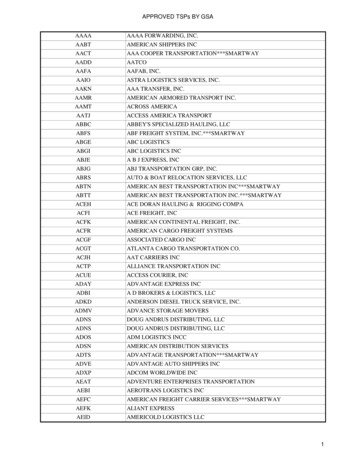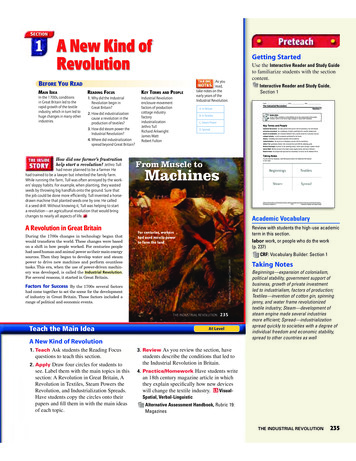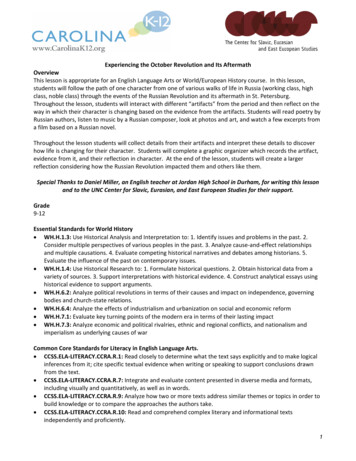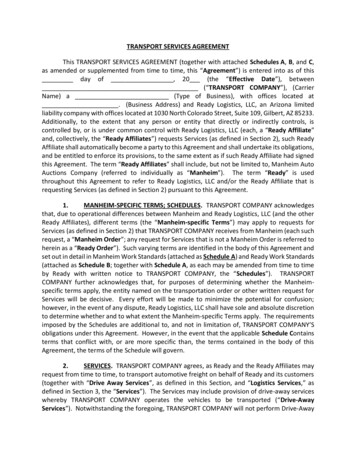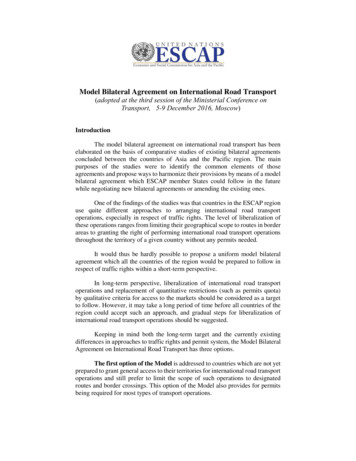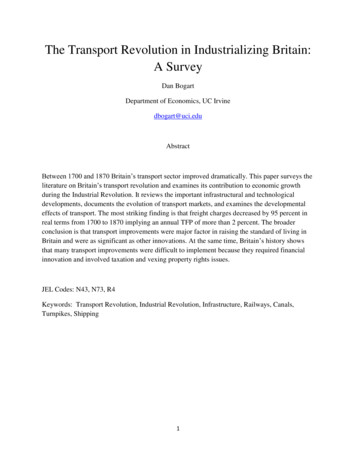
Transcription
The Transport Revolution in Industrializing Britain:A SurveyDan BogartDepartment of Economics, UC Irvinedbogart@uci.eduAbstractBetween 1700 and 1870 Britain’s transport sector improved dramatically. This paper surveys theliterature on Britain’s transport revolution and examines its contribution to economic growthduring the Industrial Revolution. It reviews the important infrastructural and technologicaldevelopments, documents the evolution of transport markets, and examines the developmentaleffects of transport. The most striking finding is that freight charges decreased by 95 percent inreal terms from 1700 to 1870 implying an annual TFP of more than 2 percent. The broaderconclusion is that transport improvements were major factor in raising the standard of living inBritain and were as significant as other innovations. At the same time, Britain’s history showsthat many transport improvements were difficult to implement because they required financialinnovation and involved taxation and vexing property rights issues.JEL Codes: N43, N73, R4Keywords: Transport Revolution, Industrial Revolution, Infrastructure, Railways, Canals,Turnpikes, Shipping1
IntroductionThe British economy c.1700 was mired in a world of high transport costs. It is true that one couldtravel by coach between London and important cities in the southeast already in 1700 and thatcoal was being shipped on coastal vessels from Tyne to London, but for much of the economyhigh transport costs were a major constraint on economic activity and travel. In the one hundredand seventy years that followed transport improved greatly. Road transport evolved frompackhorses and small wagons to large wagons and stagecoaches running continuously betweenLondon and major cities. Eventually steam powered rail wagons and coaches would displaceboth horse-drawn wagons and stagecoaches resulting in a fundamental change in freighttransport and travel. Similarly large barges and vessels powered by steam eventually displacedsmaller vessels on rivers and in the coastal trade. Along with technological change there wastremendous investment in transport infrastructure most notably in the canal and rail network.By 1870 Britain had experienced what historians have called a transport revolution(Bagwell 1988). The most clear indicator being the dramatic increase in travel speeds anddecline in freight rates. As this paper will document, railway freight charges per ton mile in 1870expressed in real terms (i.e. adjusting for inflation) were equal to one-twentieth the freight chargeper ton mile for horse-drawn wagons in 1700. Journey travel times by railway were one-tenth thetravel time of coaches in 1700. Although such calculations emphasize the importance ofrailways, this paper will show they are not the entire story. There were significant reductions inroad transport freight charges and journey times before the railways and of primary importanceto industry and mining there were large reductions in transport costs associated with the shiftfrom roads to canals. There were also major improvements in coastal travel speeds with thecoming of the steamship. Long distance shipping also witnessed dramatic reductions in freightcharges especially along the North Atlantic routes.Productivity growth was the driver of the transport revolution and played a key role indetermining fares and freight charges in the transport market. This paper summarizes estimatesof productivity growth in the literature. It also gives a new estimate for the rate of productivitygrowth in the overland transport as a whole including within mode changes (i.e. improvementswithin road or rail transport) and between mode changes (i.e. shifts from road to rail). The2
estimates demonstrate that transport experienced high productivity growth on par with other keysectors of the industrial revolution like textiles, iron, and mining.Market structure and institutional factors were also important in influencing transportmarkets. Competition was a key factor in driving down freight charges and fares for carriers andcoastal shippers. At times there was also competition among infrastructure providers liketurnpike roads, canals, ports, and railways and for this reason rates of return on infrastructureinvestments were generally modest. Britain’s transport policies were generally laissez faire:barriers to entry were modest, private ownership was common, and the property rights ofinfrastructure providers were generally protected. At the same time there was governmentintervention. Governing authorities protected the property rights of landowners creating somecomplications for canals and railways. Moreover Parliament set toll caps on turnpike roads andinland waterways partly with the aim of reducing monopoly profits. A general assessment oftransport policies is beyond the scope of this paper, but there is a case that Britain’s regulatoryinstitutions had salutary effects up to the railway age. By 1870, however, there are signs ofregulatory failure.The final section of this paper considers the developmental effects of transportimprovements. The social savings method is discussed as well as alternative approachesemphasizing changes in land values and growth accounting techniques. The estimates point to alarge role for transport improvements in contributing to income per capita growth from 1700 to1870. Transport improvements—both infrastructural and technological—were central toBritain’s early industrialization.Technological and Infrastructural DevelopmentsThere were many important developments in Britain’s transport sector between 1700 and 1870.It is impossible to cover all the details here, but a brief outline of is useful. Interested readersshould consult Bagwell and Lyth (2002) and Freeman and Aldcroft (1988, 1983) for the broaderhistories. The traditional segments of the transport sector were road, river, and coastal shipping.Despite their label, all three experienced technological and infrastructural development from1700 onwards. Road transport could take various forms, including travel by horse, wagon, orcoach. Wagons became progressively larger in size during the 1700s. The typical loads increased3
from a few tons to 6 or 7 by 1800. There were also innovations in wheels, springs, axles, andframes allowing coaches to achieve higher speeds and greater comfort. Coach designs becamenoticeably varied and included the stagecoach, post-coach, the phaeton, and landau (Strauss1912). The organization of road transport also became increasingly sophisticated. The Londonmarket was known for having professional carriers by the late 1600s and provincial servicesbecame increasing professionalized as the eighteenth century progressed (Gerhold 2005,Turnbull 1977). As professional carriers came to dominate they became larger and betterorganized. Schedules were designed so that wagons and carriages would remain idle as little aspossible. Firms also entered into long-term contracts with innkeepers and cut major componentsof their costs (Gerhold 1996).Road quality and capacity were crucial to the functioning of road transport. Simply put: itwas very difficult to run wagons and coaches at high speeds or with large loads over roads withuneven surfaces or steep inclines. It is often thought that Britain had poor roads in theseventeenth century. This is only partly true. Gerhold (2005) shows that wagons and coacheswere used to travel between London and most provincial cities in the South and Midlands in thelate seventeenth century. Packhorses were the superior technology on bad roads and remainedcommon in the North and West of Britain. While the image of seventeenth century roads hasbeen rehabilitated to some degree, one should keep in mind that traffic volumes were extremelylow by late eighteenth century standards. In the pre-industrial era, highly trafficked roadsdeteriorated rapidly if there was insufficient maintenance.Britain’s system of road financing c.1700 was ill-equipped to meet the growing need formaintenance. Since 1555 parishes were made responsible for road maintenance within theirboundaries. Parishioners were required to work six days and donate teams of horses andmaterials. Later parish and county officials were allowed to levy highway rates for local roadmaintenance (Albert 1972). The system of parochial road maintenance proved to be ineffectiveand various solutions were tried like limiting load sizes or forcing parishes to levy taxes toimprove their roads. In the end an alternative solution was found: the turnpike trust. Trusts wereauthorized by acts of Parliament to levy tolls, purchase land, and issue bonds on specifichighways. They proliferated in the eighteenth century and created a large toll road network.Around twenty thousand miles or roughly 20 percent of all highways for wheeled carriages came4
under the authority of turnpike trusts in the early 1800s. Pawson’s (1977: 51) map illustrates thedensity of the turnpike road network in 1770.Although turnpike trusts were created to improve roads, there are reasons to questionwhether they increased road maintenance and investment spending. Perhaps parishes werealready spending a lot and turnpike trusts simply displaced their efforts. Detailed research onindividual highway spending has confirmed that parishes actually spent very little prior toturnpike trusts (Bogart 2005a). However, there is a still a possibility that parishes might havespent the same in the absence of turnpike trusts. To address this concern the present author hasstudied the behavior of parishes along roads where proposals for turnpike trusts failed inParliament in the early 1700s. In such settings one can plausibly examine how parishes would5
have spent in the absence of turnpike trusts. The evidence suggests that parishes would not haveramped up their spending levels (Bogart 2005a). Before leaving this issue, it is worth noting thatparishes did more on local roads. Parish spending levels increased significantly in the early1800s. Their efforts were bolstered by the growth in local traffic and by engineering innovationsassociated with John Macadam and Thomas Telford.How effective were Britain’s road network and its carrier or coach services on the eve ofthe railway age? Some insights can be gained from a comparison with other countries. At thevery least, Britain had a more dense road network. Around 1840 Britain had more than two timesthe number of paved road kilometers per square kilometer than France or Spain (Bogart,Drelichman, Gelderblom, and Rosenthal 2010: 89). Only the Southern Netherlands hadcomparable road density by 1840 and interestingly it was one of the few countries or territoriesthat also relied extensively on tolls. In terms of travel speeds, Britain’s road network alsocompares favorably. Szostak (1991: 70) uses a sample of routes to show that in 1760 the averagetravel speed in France was 50 percent of the average travel speed Britain. By 1780 speedsincreased in both countries but the average in France was still around 70 percent of the averagein Britain. Britain had a communications advantage over its military rival at the beginning of theIndustrial Revolution.Britain had a further advantage over much of Europe in that it had an extensive networkof navigable rivers and a long coastline. As demonstrated by Willan (1964) many of thepopulated parts of Britain were within 15 miles of a navigable river or coastline already in 1600.Many of these rivers, like Thames and Severn, were the main conduits of trade between theinterior and large cities like London and Bristol. The main advantage of river transport was cost.Freight charges by river were one-fifth or one quarter of the charges by road. The problem wasthat rivers did not exist everywhere and they did not always provide the most direct route tocities. As a result, road transport could co-exist and sometimes exceed river transport in terms oftotal volume. Consider, for example, overland trade to London. Areas in the Thames river valleycould ship grain by water but much of the grain surplus from the Home counties, includingBedfordshire, Hertfordshire, and Buckinghamshire had to be shipped by road as they had noriver route to the capital. Such regions relied on road transport until the canal and railway era.6
The inadequate coverage of the waterway network was addressed to some degree byimprovements in river navigation. Much like turnpike trusts, Parliament endowed rivernavigation companies with rights to levy tolls. The stated aim was to extend the navigation ofrivers into the interior. Since the middle ages, ‘Sewer Commissions’ had powers to taxlandowners to cleanse rivers, but they were wholly inadequate to pay for expensive and largescale improvements in navigation. For this one needed clear legal authority to take land andproperty as well as a source of income to pay for the fixed costs and damages like flooding ofland. River navigation companies were given the necessary powers to finance improvements andtheir accompanying legislation addressed some of the property rights dilemmas that could plaguesuch projects (Willan 1964).River navigation companies invested significant sums from 1690 to 1750. The result wasan extension in the number of miles of navigable river from around 850 to 1600 by the year1750. Improvements in navigation were made to the rivers Trent, Derwent, Aire, Mersey, andWeaver among others. Many would serve industrial regions in the Midlands and North.Coastal shipping was another vibrant form of transport in the early 1700s. Freight rateson coastal vessels were lower than on any other mode of transport including river barges. Theonly problem was that ships could be delayed due to weather and shipwrecks were always aconcern. For these reasons, the eighteenth century coastal trade was largely concentrated on theeast coast. The largest port was London which also served as the center for foreign or colonialbound vessels. The next largest coastal ports included Newcastle, Sunderland, and Scarboroughall in the northeast (Jackson 1983). The most common cargo was coal. Its low value to weightmeant that coastal shipping was by far the best mode of transport. Other commodities like grainwere common on coastal vessels especially in the East Anglia region.The degree of technological and organization change in coastal shipping appears to havebeen extensive during the eighteenth century and was derived from various sources. Accordingto Ville (1986), the design of hulls and sails improved allowing for more power and durability.Vessels increased in size allowing for greater capacity. There were also changes in loadingpractices and technologies that led to more voyages per year. Finally, there were also increases inport capacity over the eighteenth century. Major dock works were undertaken in Lancaster,Liverpool, Hull, Goole, Grimsby, Bristol, and London during the early 1800s. As in the case of7
river navigation and roads, projects were authorized by acts of Parliament and were undertakenby joint stock companies or trusts (Jackson 1983). In spite of these developments, Hausman(1987) has raised doubts about the degree of improvement in coastal shipping. The critique isbased on estimates of the rate of total factor productivity growth in coastal shipping. Themethodology will be discussed below, but for now it is worth stating that technological andorganizational change does not necessarily translate into large productivity growth. Themagnitude of improvements and the cost of the inputs being saved by technologies matter forproductivity growth.Transport Revolutionized: Canals, Railways, and SteamshipsTraditional forms of transport were improved through technological and infrastructuraldevelopments between 1700 and 1830, but even allowing for their significance, canals, railways,and steamships were the locus of the transport revolution in Britain. Canals were importantbecause they extended water transportation to important areas of the economy. Birmingham, forexample, had no navigable rivers and Manchester was ill-served in its hinterland. The problemwas partly a matter of endowments. In some areas there were no streams or rivers to makenavigable or the terrain was too rugged. The other problem was technological. Engineers neededto learn how to build reservoirs, to divert water long distances, and to use sophisticated locks todeal with changes in elevation. Canals embodied these innovations and brought inland watertransportation to much of the interior regions of Britain. The waterway network c1830 is shownin Duckham (1983)’s map.8
Canals introduced a number of property rights issues, much like the rivers that precededthem. Local landowners were aware of the potential gains from shipping their produce to marketmore cheaply, but they bore the brunt of the costs. Their land needed to be taken and whatremained might suffer residual damage from flooding and traffic along tow paths. How was the‘takings problem’ solved? Like most infrastructure improvements in Britain, canal companiesreceived authorization from Parliament before implementing their project. One of the most9
important provisions of these acts concerned negotiations with landowners. The acts stated thatin the event landowners and canal companies could not reach agreement, a jury was to beimpanelled to determine compensation. Juries were arguably necessary because landownerswould like to hold-up canal companies by charging them an excessive price for their land. Ofcourse, the canal company had the opposite goal and wanted to minimize the price. Thespecificity and the multiplicity of landowners made coming to an agreement difficult. Juriesoffered a quick resolution to this bargaining problem but they did so at a price. Case studies haveshown that juries were friendly to landowners when determining compensation (Kostal 1994,Bogart 2011).Even beyond the need to compensate landowners, canals required substantial capitalinvestment. According to Ward (1974), 17 million pounds was invested in canals between 1755and 1815. To put this figure into perspective, the value of capital invested in turnpike roads isestimated to be around 10 million in the early 1820s (Bogart 2012). Canals were the largestinfrastructure investment in Britain by their time. Canals relied on local sources of financing.The landed interest played a role, but it was the mercantile and industrial sector in the area thatprovided the majority of funds (Ward 1974). The size of investment in canals appears to havestretched local capital markets to the limit particularly during the canal mania of the 1790s.London financiers stepped into to provide some needed capital. A number of financialinnovations increased London’s involvement. One was the emergence of intermediaries likebrokers. In several provincial cities, like Oxford and Leicester, brokers helped transfer shares innewly formed companies (Ward, 1974: 106-107). Another innovation was the interest-bearingoptional note. Optional notes were first issued by the Grand Junction canal in the late 1790s. Itgave the holder the right to convert the bond into a share at face value. They were particularlypopular among London investors (Ward 1974: 71).There was a strong link between banks and canals as well. Ward documents several caseswhere banks extended credit to canal companies in the 1790s (p. 112). He also notes thatbankers were typically treasurers for canal companies. Bankers’ knowledge of the Londoncapital market might have been imparted on the directors of canal companies who generally hadmore expertise in local affairs or engineering. Moreover bankers likely conveyed information10
about canals to investors in London, which would further reduce search costs between companiesand investors.Canals provided for the transportation of bulky goods, most notably coal, which arguablycould not have been met with land carriage. One indicator of their importance is the closeassociation between the construction of canals and reductions in the price of coal or the growthof coal output. Turnbull (1987: 550) gives an example of the Lancashire coalfield where outputmore than tripled between 1773 and 1790 following the construction of the Leeds and Liverpoolcanal. One complication in linking canals with economic growth concerns their endogenousdevelopment. Canals were often constructed in areas and at times of substantial economicgrowth. In the previous example, Lancashire was booming in the late eighteenth century in partbecause of innovations in the textile industry. One might argue that output growth in theLancashire coalfield would have continued without canals. As we shall discuss later, moresophisticated methods are needed to identify the contribution of transport innovations like canals.The role of canals in the transportation of industrial goods is less clear than for heavygoods like coal. There are numerous examples of factories locating near canals, but these werealso places with turnpike roads. Freeman (1980) has studied the relative advantages of road andwaterway transport in the case of the cotton textile industry. The records of spinning firmssuggest they relied on roads when speed was essential. Canals companies tried to increase thespeed of services through the introduction of ‘fly-boats,’ but they were not entirely successful.Regulation is one reason. Parliamentary acts gave canal companies a monopoly over theinfrastructure, but not the services using the waterway. Canals might have been more successfulin taking passenger and high value traffic if they could dictate the types of services offered.Britain’s canal network was a major achievement in spite of any limitations on speed. Itssignificance can be seen in a comparison of waterway density across countries. As late as 1850,England and Wales were ahead of France, Spain, and the German Empire in kilometers ofnavigable waterways per square kilometer. Only the Netherlands and Belgium had more (Bogart,Drelichman, Gelderblom, and Rosenthal 2010: 89). Britain’s waterway advantage over Francewas greatest by the end of the Napoleonic Wars when Britain had nearly three times thewaterway density of its economic and military rival (Szostak 1991: 55).11
Railways were of equal and possibly greater significance to inland transportation thancanals. Railways succeeded in market segments where canals failed. They came to dominatepassenger travel and the shipment of high value goods because they offered speed and comforton an unprecedented scale. Long distance travel by wagon and coach had no chance of surviving.Railways companies were also vertically integrated, owning both the track and the vehicles. Itwas the first time in British transport history where market power was so heavily concentrated.Railways were a major technological achievement and innovations in steam power werecrucial to their development. Railways began as horse-drawn wagons on iron rails. GeorgeTrevithick was the first to develop a steam powered road carriage to replace horses. GeorgeStephenson made further improvements and along with his son Robert they developed the firsthigh-pressure steam locomotive in the 1820s. One of the most important technological decisionswas the choice of gauge width. George Stephenson used the 4 ft. 8.5 in. gauge in constructing theManchester and Liverpool railway during the 1820s. Stephenson’s gauge became the mostcommon width among early railways, but others were tried ranging from 3 ft. 10 in. to 5 ft.Interestingly it does not appear that Stephenson favored this width because of any advantages insteam locomotion. By the 1840 several prominent engineers advocated gauges ranging from 5 ft.to 7 ft. on the grounds that operating costs would be lower, especially on high volume routes(Puffert 2010). Gauge width had become a contentious issue and broad gauge regional networksemerged in western Britain following the lead of Brunell’s Great Western railway. As it turns outthe savings from broad gauges proved to be illusory and the costs associated with breaks ofgauge mounted with time. By the 1870s many broad gauge networks were converted to theStephenson gauge, but not after substantial costs had been incurred (Puffert 2010).Like turnpikes and canals, railways were authorized by acts of Parliament. As a result,investors and private interests dictated the development of the network much more than theGovernment. The Railway Mania of the mid-1840s was one of the most famous episodes ofprivate railway promotion. In the pace of a few years, several hundred railways were authorizedin parliament. Although some good quality projects were proposed, more were speculative. Afraction of the lines authorized in the Railway Mania were completed, resulting in large lossesfor some investors (Odlyzko 2012). The railway board proposed a more rational development of12
the network around the same time, but their recommendations were largely ignored (Casson2011).Along with technology and regulation, financing played a key role in railwaydevelopment. By 1870 the railway capital stock is estimated to be 232 million in 1869 prices(Hawke 1970: 200). To put this figure in perspective, recall that around 17 million was investedin canals by 1815 and 10 million was invested in turnpikes by the 1820s. Although much largerin scale, railway investment was similar in character to canals. Local landowners, merchants, andindustrialists subscribed the most capital. London financiers played a complementary role at firstand increased their contributions with time. Why did financing consist of a mixture of local andcentralized financing? Trew (2010) argues that London financiers initially faced an initialinformational disadvantage, but they become more efficient through learning by doing. At thatpoint, the London market took over and railway investment accelerated.The last revolutionized transport sector was shipping. The application of steam powerwas one of the key developments. Steam power was first applied to coastal shipping withpassenger services starting in the 1810s. On some routes, steam ships had a speed and costadvantage over stagecoaches. Their market share reached its zenith in the early 1840s (Bagwelland Lythe 2002: 25). Steamships continued to fill a gap in the market not be met by railwayseven as late as 1910 (Armstrong 1987).The application of steam power was clearly important, but how much of an advance wasit compared to earlier developments in shipping? North (1968) and Walton and Shepherd (1972)examined this issue in the context of North Atlantic shipping. They argued for significantproductivity growth in the age of sail and emphasized shorter loading times and improvements inpackaging. There is another intriguing explanation relating to piracy. Previously ships had to armthemselves to protect their crew and cargo. However, there was a possibility to reduce thesecosts as there were economies of scale in defense. North argues that the British Navy performedthis task well enough so that private ships became more cost efficient. North’s argument’sarguments have not gone unchallenged. Harley (1988) showed that most freight rates in Britishshipping did not decline substantially until the 1860s. Harley emphasized the importance ofsteam power and metal hulls. The North-Harley debate raises some interesting questions. Can thetransport sector become more productive solely through technological change or do13
organizational and institutional changes matter in a significant way? Research will continue todebate this question.The Evolution of the Transport MarketTransport markets evolved greatly from 1700 to 1870 due to the technological and infrastructuraldevelopments. Prices and output are good indicators of these changes. Table 1 gives an estimateof average passenger fares and travel speeds for stagecoaches and railways. In 1700 passengerfares were around 0.18 shillings per passenger mile. In other words, the price for one person totravel one mile was 0.18 shillings. By 1760 stagecoach fares had risen to 0.23 per passenger mileand by 1800 they were 0.4 shillings. Fares clearly increased in nominal terms, but not necessarilyin real terms. Dividing the fare by a consumer price index gives the real change. I use Clark’s(2010) consumer price index to convert fares into 1700 prices. The resulting calculation shows amodest increase in real passenger fares from 1700 to 1800.Table 1: The Evolution of Transport Costs and Travel SpeedsStagecoach Fares inshillings per passenger mileStagecoach Speeds injourney miles per hourTime cost perpassenger milecurrentpricesconstant1700 .17502.610.07c.18000.40.21c.18207.960.04Railway Fares inshillings per passenger milec.1865 second classcurrent pricesRailway speeds injourney miles per hourcurrentpricesconstant1700 prices0.130.08c.187023.20.02c.1865 third class0.080.05Sources: for stagecoach fares and speeds see Gerhold (2005: 177-236), Bogart (2005: 505-506)and Laudner (1855: 180). For railway fares and speeds see Hawke (1970: 77) and Leunig14
(2006: 642, 646). Time cost is calculated as the time for a one mile journey multiplied by onehalf the hourly wage of a building craftsman. See Clark (2010) for building craftsman daywages and the 10 hour working day.Although stagecoach fares were roughly constant from 1700 to 1830, journey times werenot. Travel speeds are difficult to measure because of stoppages along the way. Journey milesper hour (journey distance divided by total travel time) are measured better and serve as the usualindicator. Average journey miles per hour were 1.96 in 1700, but there was a difference betweensummer and winter travel times. In summer the average journey speed was 2.26 and in winter theaverage journey speed was only 1.48 (Gerhold 2005). Moving forward in time, the averagejourney miles per hour in 1750 was only slightly higher at
The Transport Revolution in Industrializing Britain: A Survey Dan Bogart Department of Economics, UC Irvine dbogart@uci.edu Abstract Between 1700 and 1870 Britain’s transport sector improved dramatically. This paper surveys the literature on Britain’s transport revolution



